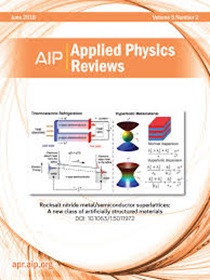Linear flip-chipped resonant-cavity green μLEDs arrays for low-crosstalk optogenetic probes with low damage
IF 11.9
1区 物理与天体物理
Q1 PHYSICS, APPLIED
引用次数: 0
Abstract
Optogenetics with high temporal and spatial resolution hold great potentials to replace the traditional drug and electrical stimulation techniques, which calls for optical probing devices with low crosstalk and organic damages. Here, we report a fabrication method of optoelectrical probes for precise modulation of neurons. A linear array of flip-chipped green resonant-cavity μLEDs (RCLED) with an emitting aperture of 50 μm is integrated on Si platform as the stimulation source. Due to the top/bottom Bragg reflectors, the RCLEDs' output light view-angle is narrowed to <90°. The emission wavelength demonstrates remarkable stability under various injection current densities. Under the 50 A/cm2 driving current density, the RCLEDs' output optical density is 100 mW/mm2 and maximum temperature rise is 0.5 °C, both of which exhibit great improvement compared with those of the optical probes on sapphire substrate. Using these green RCLED probes to stimulate Mac-mCherry photosensitive protein, the analgesia and inhibition effects for medium prefrontal cortex GABAergic neurons are verified. This work provides an effective approach to fabricate integrated microscale light sources for precise stimulation and modulation of neurons, which facilitate the study of complex neural functions.用于低串扰低损伤光遗传探针的线性倒装谐振腔绿色μ led阵列
具有高时空分辨率的光遗传学技术具有取代传统药物和电刺激技术的巨大潜力,这就需要具有低串扰和有机损伤的光探测装置。在这里,我们报告了一种用于神经元精确调制的光电探针的制造方法。在Si平台上集成了一组发射孔径为50 μm的倒装绿色谐振腔μ led (rced)线性阵列作为激励源。由于顶部/底部布拉格反射器,rled的输出光视角被缩小到90°。在不同的注入电流密度下,发射波长表现出显著的稳定性。在50 A/cm2的驱动电流密度下,rled的输出光密度为100 mW/mm2,最大温升为0.5℃,与蓝宝石基板上的光学探头相比有很大的提高。利用这些绿色rced探针刺激Mac-mCherry光敏蛋白,验证了对中额叶皮质gaba能神经元的镇痛和抑制作用。本研究为精密刺激和调节神经元的集成微光源的制备提供了有效途径,为复杂神经功能的研究提供了便利。
本文章由计算机程序翻译,如有差异,请以英文原文为准。
求助全文
约1分钟内获得全文
求助全文
来源期刊

Applied physics reviews
PHYSICS, APPLIED-
CiteScore
22.50
自引率
2.00%
发文量
113
审稿时长
2 months
期刊介绍:
Applied Physics Reviews (APR) is a journal featuring articles on critical topics in experimental or theoretical research in applied physics and applications of physics to other scientific and engineering branches. The publication includes two main types of articles:
Original Research: These articles report on high-quality, novel research studies that are of significant interest to the applied physics community.
Reviews: Review articles in APR can either be authoritative and comprehensive assessments of established areas of applied physics or short, timely reviews of recent advances in established fields or emerging areas of applied physics.
 求助内容:
求助内容: 应助结果提醒方式:
应助结果提醒方式:


